- Continue Shopping
- Your cart is empty
Antique Periods
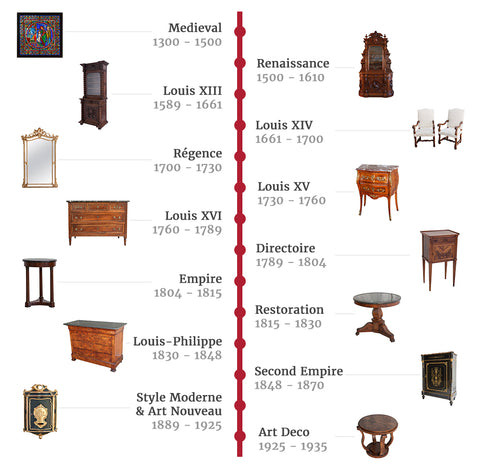 Select an antique period below to learn more:
Select an antique period below to learn more:
Renaissance: 1500-1610
Louis XIII: 1589-1661
Louis XIV: 1661-1700
Régence: 1700-1730
Louis XV: 1730-1760
Louis XVI: 1760-1789
Directoire: 1789-1804
Empire: 1804-1815
Restauration: 1815-1830
Louis-Philippe: 1830-1848
Second Empire: 1848-1870
Style Moderne and Art Nouveau: 1889-1925
Art Deco: 1925-1935
Medieval Period: 1300-1500
 The Medieval Period is also known as the Gothic Period, and authentic antique pieces from this period are rare. However, they serve as a reference point in the history of furniture since they are the ancestors of all French furniture that follows.
The Medieval Period is also known as the Gothic Period, and authentic antique pieces from this period are rare. However, they serve as a reference point in the history of furniture since they are the ancestors of all French furniture that follows.
Characteristics
The most important characteristic of medieval furniture is its stability of form. Few changes in shapes or lines occurred from the eleventh century to the end of the fifteenth century. Seating was very rudimentary consisting of simple planks of oak fixed to trestles to form benches or stools. Chairs often consisted of a chest with a highly decorated front panel surmounted by a high back and two arms. Armoires consisted of two or three superimposed units with hinged doors. Highly carved chests were the most characteristic pieces of the period.
Materials
Oak was used until the end of the fifteenth century. The use of walnut arrived thereafter. Wrought iron was used for hinges, door braces, locks, handle and studs.
Ornament
Ornamental themes of the medieval period were all inspired by the religious fervor of the times. Rosettes, lancet arches and interlace recalled the Gothic churches. Legends of saints and scenes from the Gospels were the theme for figure compositions. The majority of ornament was painted or carved, sometimes entirely polychrome.
Renaissance Period: 1500-1610
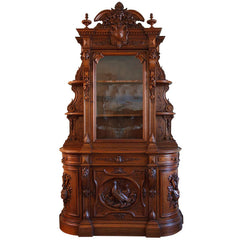 French Renaissance style is basically a translation of the Italian Renaissance style with a few of its own distinguishing features.
French Renaissance style is basically a translation of the Italian Renaissance style with a few of its own distinguishing features.
Characteristics
The buffet is the most characteristic type of furniture. Called the Henri II buffet after the French king who reigned from 1547 to 1559, it underwent a revival at the end of the nineteenth century and was mass-produced between the years of 1860 and 1900. These pieces are quite large and consist of two superimposed units often culminating in a pediment or cornice. Doors are ornately carved and decorated with mirrors, medallions, and garlands. The support posts often take the form of caryatids. Feet are short and squat.
The Louis XIII Style: 1589-1661
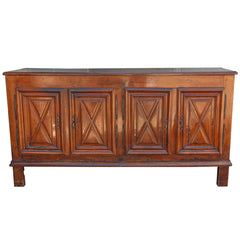 The reign of Louis XIII was from 1610 to 1649, but the Louis XIII style extended to the beginning of Louis XIV's reign in 1661. The influence of the Spanish, Italian and Flemish dominated the European fashion in both dress and furniture. Interior rooms became more numerous and more use-specific. A demand for furniture, tapestry and textiles followed with a growing taste for the sumptuous. Creative imagination was appreciated in both design and ornament. A national style eventually came to the forefront, which would lead to the place of leadership in French style under Louis XIV.
The reign of Louis XIII was from 1610 to 1649, but the Louis XIII style extended to the beginning of Louis XIV's reign in 1661. The influence of the Spanish, Italian and Flemish dominated the European fashion in both dress and furniture. Interior rooms became more numerous and more use-specific. A demand for furniture, tapestry and textiles followed with a growing taste for the sumptuous. Creative imagination was appreciated in both design and ornament. A national style eventually came to the forefront, which would lead to the place of leadership in French style under Louis XIV.
Abroad
England: The Elizabethan style
Italy: Mannerism
Spain: End of the Siglo d'oro
Furniture
Louis XIII furniture is geometric in appearance with a tendency toward the architectural. Massive forms feature veneer, turned wood and moldings.
 Materials & Techniques
Materials & Techniques
Woods used in the period were oak, walnut, ebony, pear wood and pine. Turning was used widely in chairs, on table stretchers, chests and cabinets, and on the colonnettes of armoires. Serpentine columns and barley twist were especially predominant. Moldings were used prominently to frame doors, panels and drawers, as well as to give prominence to cornices and to create geometric patterns in panels.
Ornament
Heavy, massive motifs were in favor. Decorative motifs include the drapery swag, the cartouche, palm fronds, chimeras, acanthus leaves, ball and claw, putti, scallop shells, cornucopias, bulging vases, eagles with spread wings, ovals, feathers and lion and ram heads.
Louis XIV Period: 1661-1700
 Louis XIV, known as the Sun King, was an absolute monarch and a sort of superhuman personification of the state ("L'Etat, c'est moi.") It was thus that the Louis XIV style was imposed on all of the artistic productions of the period. It soon spread throughout Europe, replacing that of Italy and Spain. The French aesthetic was extremely formalist and indifferent to reality. The Louis XIV style is characterized by balance, symmetry, formal amplitude, and a deep distrust of disorder and natural caprice.
Louis XIV, known as the Sun King, was an absolute monarch and a sort of superhuman personification of the state ("L'Etat, c'est moi.") It was thus that the Louis XIV style was imposed on all of the artistic productions of the period. It soon spread throughout Europe, replacing that of Italy and Spain. The French aesthetic was extremely formalist and indifferent to reality. The Louis XIV style is characterized by balance, symmetry, formal amplitude, and a deep distrust of disorder and natural caprice.
Abroad
England: The William and Mary style and the beginning of the Queen Anne style
Italy: The Baroque
Spain: Churrigueresque style
Furniture
The Louis XIV style closed the age of multiple-use pieces and ushered in a new era of individualized, use-specific furniture. Generic chests continued to be made only in the provinces, and the last cabinets were executed by the cabinetmaker of Louis XIV, André-Charles Boulle (1642-1732). The painter Charles Le Brun who was entrusted with the decoration of Versailles coordinated the activity of the ébénistes, or specialists in luxury case furniture. The ébénistes were indeed servants of the Sun King himself.
Materials & Techniques
Chestnut, walnut and oak were the predominant materials for the large solid-wood pieces of the period. Case furniture was often made of more than one kind of wood: oak for the main case, poplar or pine for secondary elements. Boulle was the supreme master of marquetry and various woods and contrasting colors were incorporated into the Boulle marquetry. These included almond wood, boxwood, holly wood and pear wood. Bronze was often used as ornamentation as well as for reinforcement of the structure of a piece.
 Ornament
Ornament
The rigor and symmetry in the Louis XIV ornament resulted in balanced and majestic compositions. Straight lines are softened by garland motifs, dentils and fluting, but there are fewer columns and pediments than in the Louis XIII furniture. Curved lines are short and not predominant. Right angles are softened by bronze mounts.
Moldings are thick, responding to a need for symmetry and framing. Fielded panels are usually notched in all four corners or only in the two upper corners. They are also often arched but with four right angle corners or with shaped indents.
Decorative motifs are sumptuous and resonate with the grandeur of the Louis XIV style. Human masks sometimes radiating solar rays as well as mascarons of grotesque faces that emerge from vegetation are common motifs. Motifs of animal origin include scallop shells, lion heads, lion claws, ram heads, dolphins, gryphons and hooved feet. Motifs of vegetable origin include the oak, laurel, olive, fleur-de-lys (emblem of the Bourbon kings), festoons of fruit and flowers and acanthus and waterleaves. Architectural motifs include balusters, consoles, modillions, dentils and triglyphs. Axes, shields, helmets and arrows are martial attributes that appear on the furniture of the day. Motifs borrowed from tapestry design such as tassels, drapery knots and ribbons also commonly appear.
The Régence Style: 1700-1730
 The regency of Philippe d'Orléans lasted from 1715 to 1723, but the Regency style emerged at the beginning of the century and continued into the reign of Louis XV. The Regency state of mind was a reaction to the strict rules of etiquette in the Louis XIV court. The turn was toward intimacy, comfort, distraction and pleasure and away from the stiff ceremony of the court. The glory and majesty of the Louis XIV era gave way to the grace and charm of the Régence whose elegance is reflected in the new furniture of the day.
The regency of Philippe d'Orléans lasted from 1715 to 1723, but the Regency style emerged at the beginning of the century and continued into the reign of Louis XV. The Regency state of mind was a reaction to the strict rules of etiquette in the Louis XIV court. The turn was toward intimacy, comfort, distraction and pleasure and away from the stiff ceremony of the court. The glory and majesty of the Louis XIV era gave way to the grace and charm of the Régence whose elegance is reflected in the new furniture of the day.
Abroad
England: End of Queen Anne period
Italy: End of Baroque period
Spain: Philip V style (imitation Boulle)
Furniture
The furniture of the Régence period became less bulky in the interest of comfort and intimacy. Pieces of furniture became smaller, easier to move and more numerous. Their lines grew more fluid and curvaceous. Forms were more elegant and agreeable to the eye. Régence is a transitional style with conservative and new elements in the same piece.
Materials & Techniques
Oak was the wood of choice for the finest furniture pieces. Pine and poplar were used for the more ordinary ones. Beech, walnut, fruitwoods or lime wood was used for seating. Natural woods were favored but gilded wood remained in fashion for consoles, ceremonial chairs and frames.
The use of wood veneer was widespread. Rosewood and kingwood were the most prized veneers. Marquetry of colored woods was set into ebony backgrounds, often in geometric patterns.
Bronze fittings were used around desk- and tabletops, as drawer reinforcements and handles, as protective sabots, or shoes, and as console espagnolettes to protect projecting corners. These fittings were of ormolu, also called bronze doré.
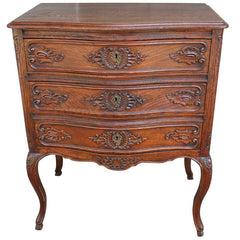
Ornament
Ornament in the Régence style is softer than in the Louis XIV style but not so supple as in the Louis XV style that it is indistinguishable from the armature it supports. Overall compositions remain symmetrical for the most part. Curved profiles become the norm. Right angles are softened by decorative motifs.
Moldings become thinner and less imposing than under Louis XIV and are in low relief. Indents and bronze fittings mask corners. Furniture of solid wood is decorated with delicate ornament on panels fielded by moldings.
Decorative motifs were widely used in both carved and bronze-mount form. Masks and mascarons are still present, but they are replaced by smiling heads of fauns and women. The lion's head from the Louis XIV style disappears. Espagnolettes, or female busts emerge from console legs and on projections of corners on desks, chests of drawers and console tables. Scallop shells are the most characteristic motif of the Régence style, but they are more natural in appearance, never twisted, as they would be under Louis XV. The bat's wing, not to be confused with the scallop shell, is also used. Toward the end of the Régence period, monkeys, dolphins, dragons, birds and chimeras appear as a decorative motif. Motifs of vegetal origin include less stylized palmettes than under Louis XIV. Acanthus leaves are longer and suppler and are worked in everywhere. Waterleaves, palm fronds and gadrooned leaves are also widely used. Some motifs of exotic origin such as pagodas, peacock feathers, parasols, humpback bridges, misshapen rocks and exotic flowers also appear.
Louis XV Period: 1730-1760

Although the reign of Louis XV extended from 1715 to 1774, the style of the same name began to emerge about 1730 and was transformed into the Louis XVI style about 1760. However, these three decades can be celebrated for the creation of the most brilliant, the most refined, and perhaps the most charming of styles ever devised. This was not only the reign of the king but also of his favorites. The royal mistresses played a very important role as models for customs, fashions and taste. The mistress of the house exerted a new influence that changed the chilly atmosphere of the palace to suites of comfortable, well-heated and intimate rooms. Rooms were smaller, more numerous and more use-specific. These rooms were furnished with attentiveness to elegance, refinement, comfort and well-being. Gone were marble walls, replaced by high paneling that was carved, painted or varnished. Gone were stone floors, replaced by wood marquetry. Mantelpieces became lower, and art objects and knickknacks were chosen with an eye for an overall effect. Everything conspired to create an atmosphere of exceptional elegance for France had become the European model for cultivated sociability.
Abroad
England: Palladian and Chippendale styles
Italy: The Rococo
Spain: Carlos IV style (rococo an antique revival)
Furniture
Louis XV is the greatest of all periods for French furniture. Materials are varied, workmanship is exceptional, and forms adapt to all manner of demand. Furniture became practical and transportable without sacrificing any of its elegance.
Materials & Techniques
Most solid wood furniture was made of oak or walnut. Beech, linden wood and walnut were used in chairs. Painted wood was often used as it fostered harmony between furniture and paneling. Gilded wood was reserved for trumeau mirrors and console tables. Colorful compositions of marquetry were in vogue due to the availability of a hundred different species. Mahogany came into use.
Bronze fittings were less refined than those on Régence furniture. Cast bronze pieces were either gilded (ormolu) or coated with a gold varnish.
Marble was used to add color highlights to furniture. Thick overhanging tops accentuated the forms of the pieces beneath them. Porcelain also came into vogue and was used in delicate rectangular or medallion plaques set into mahogany panels.
Ornament
Asymmetry is the delight of Louis XV ornament. Curved lines, c-scrolls and s-curves lend themselves to the overall fantastic and exuberant movement that make the Louis XV ornament the antithesis of the stiffness of the Louis XIV style. Decorative motifs inspired by flora and fauna were placed on bronze fittings, silver, carved wood and marquetry. Cartouches in frames of rocaille appear. Scallop shells are now irregularly shaped. Doves and dolphins are the animal motifs of choice. Stylized flowers appear everywhere. The acanthus is combined with all rocaille motifs. Attributes of love, the hunt, fishing, music and the pastoral life are significant as they celebrate the sweetness of 18th century daily life. Oriental themes such as sultans, pashas, dervishes and monkeys invade decoration as well.
Menuisiers & Ebénistes
A division of the guild of woodworkers appeared during this period. The menuisiers and ébénistes were allowed to make both solid-wood frame furniture and case furniture incorporating Boulle and wood marquetry. However, in reality, menuisiers made only solid-wood frame pieces and ébénistes made luxury case furniture. It was the menuisiers who produced beds, seating, tables, buffets, armoires and consoles made of walnut or oak. The wood sculptors who worked closely with the menuisiers did the hand carving on these pieces. The ébénistes were specialists in incorporating boulle marquetry and wood marquetry in their luxury case furniture.
Louis XVI Period: 1760-1789
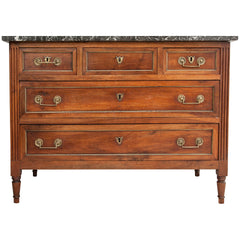 The Louis XVI style appeared fifteen years before the king ascended the throne and began to wane at the first approach of the Revolution that led to his demise. Geniality and simplicity replaced the exotic refinements and disorderly exuberance of the Louis XV style. As Marie-Antoinette played at peasantry in the Petit Trianon at Versailles, so small rustic retreats replaced the fussy elegance of the ceremonial rooms and townhouses of large cities. Antiquity was examined anew, this time characterized by reason and grace. Furniture lost its unnecessary ornamentation and lines became more restrained.
The Louis XVI style appeared fifteen years before the king ascended the throne and began to wane at the first approach of the Revolution that led to his demise. Geniality and simplicity replaced the exotic refinements and disorderly exuberance of the Louis XV style. As Marie-Antoinette played at peasantry in the Petit Trianon at Versailles, so small rustic retreats replaced the fussy elegance of the ceremonial rooms and townhouses of large cities. Antiquity was examined anew, this time characterized by reason and grace. Furniture lost its unnecessary ornamentation and lines became more restrained.
Abroad
England: The Adam style
Italy: The Neoclassical style
Spain: Carlos IV style
Furniture
Furniture types remain numerous and varied with each piece of furniture designed to fill a specific need of the refined culture of the noble class. Forms became stiffer, but the basic configuration of each piece of furniture that came into being during the Louis XV period remained much the same.
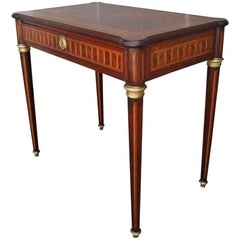 Materials & Techniques
Materials & Techniques
Oak was used for solid-wood pieces. Walnut, ash and burled walnut were used for seating and moveable pieces. Mahogany became very fashionable both as veneer and in solid-wood pieces. Ebony also came back into vogue after being banished during the Louis XV period. Satinwood also was often used under Louis XVI.
Painted pieces were trimmed in gold or another contrasting color. Gilded wood was used for ceremonial chairs, console tables and mirror frames.
Marquetry continued to enjoy favor but geometric patterns proliferated. Lozenge and checkerboard patterns, interlace, rosettes, frets and rectangles with indented corners were placed to underscore the structure of a piece. Central motifs were set within rectangle or medallions.
Turned elements became common thanks to straight lines being the new fashion. Legs and vertical supports were turned in various ways, resembling spindles, quivers, columns and balusters.
Porcelain plaques made of Sèvres porcelain or in Wedgwood relief were incorporated into pieces. Copper was used to form collars circling turned legs and as strips to accentuate panels, moldings, and fluting. Steel began to appear to set off openwork bronze and copper fittings. Bronze fittings were applied to almost all Louis XVI furniture but they were more delicate in form and thus more ornamental than protective. They are small and finely detailed and are arranged symmetrically as corner ornaments, shoes, handles and key plates. Their forms derive from antiquity (dentils, interlace, egg-and-dart and laurels), upholstery (festoons, tassels, cords, fringes and knotted ribbons) and nature (flowers, fruit, and animals all rendered naturalistically).
The marble of choice was white, gray or sometimes red with veining. It was used for the tops of commodes and tables.
Ornament
Lines are straight. Strict verticals and horizontals were the order of the day. Flat surfaces and right angles are back in vogue. Ornament was disposed symmetrically around a central axis. Moldings were thinner, more elegant and less emphatic. Wall panels were square, rectangular, or arched, and accompanied by rosettes and acanthus. The paneling corners sometimes have rectangular or rounded indents adorned with small rosettes. Decorative elements are situated toward the top and bottom of furniture panels and include floral sprays hanging from knotted ribbons, or vases and urns containing flowers and greenery.
Decorative motifs of Louis XVI style were inspired by antiquity, the Louis XIV style and nature. Objects unearthed at ancient sites are inspiration for decorative motifs. Examples are vases, urns with squared handles, tripods, braziers, dentils, eagles, dolphins and ram and lion heads. Architectural motifs were used both as supports and as decorative elements. These include fluting, cabled fluting when the cabled terminate in leaf bud motifs, pilasters, fluted balusters and columns. Female masks and figures of children are frequently used. Elements of nature include strings of olive and oak leaves, short garlands of flowers and foliage, wreaths of laurel, ivy, and flowers, pinecones and pomegranates.
Directoire Period: 1789-1804
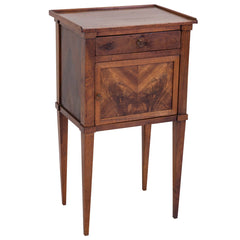 This fifteen-year period between the French Revolution and the Empire was the most troubled in French history. Three successive regimes marked the passage between the absolute monarchy of the Bourbon kings to the Empire established by Napoléon I. Gone were the Bourbons and the customs, tastes and decors of the old regime. Luxury, power and privilege were condemned. Equality, simplicity and civic virtue replaced them. However, the ideals of the Revolutionists were not always played out in their true form in the fashion of the day. Affectations of simplicity often existed side by side with conspicuous luxury. The revolutionaries suppressed the furniture guilds during this period, and thus, craftsmanship was no longer guaranteed. The new clients of the day did not have the sophistication to demand the high quality work that had been produced by the menuisiers and ébénistes of the court, and the Directoire government lacked the authority to insist upon it.
This fifteen-year period between the French Revolution and the Empire was the most troubled in French history. Three successive regimes marked the passage between the absolute monarchy of the Bourbon kings to the Empire established by Napoléon I. Gone were the Bourbons and the customs, tastes and decors of the old regime. Luxury, power and privilege were condemned. Equality, simplicity and civic virtue replaced them. However, the ideals of the Revolutionists were not always played out in their true form in the fashion of the day. Affectations of simplicity often existed side by side with conspicuous luxury. The revolutionaries suppressed the furniture guilds during this period, and thus, craftsmanship was no longer guaranteed. The new clients of the day did not have the sophistication to demand the high quality work that had been produced by the menuisiers and ébénistes of the court, and the Directoire government lacked the authority to insist upon it.
Abroad
England: The Adam style
Italy: The Neoclassical style
Spain: Carlos IV style
Furniture
The weak economic situation during the Directoire had a direct impact on the furniture production of the day. The simplification process begun under Louis XVI along with a taste for classical forms continued. The furniture of this period is elegant and gracious, heralds references of antiquity and comes to fruition in the Empire style.
 Materials & Techniques
Materials & Techniques
Most furniture from this period is solid wood: elm, walnut, fruitwood or beech. Only luxury work is made of solid and carved mahogany or has mahogany veneer. Painted pieces in gray, white, sea green and lime green boasted carved ornament painted in a contrasting color or different shades of the same color. Marquetry disappeared entirely and bronze fittings became rare.
Ornament
Directoire ornament is spare and light and is inspired by the Greek and Pompeian models. Lines are straight with crisp geometric forms. Surfaces are flat and corners are clean. Characteristic motifs include squares, rectangles and palmettes. Single lozenges contain a motif, often a Greek urn or medallion. Motifs of antiquity of the Directoire period also include tureens, columns, arrows, dragons, winged lions, swans and gryphons. Sphinxes, lotus flowers, pyramids and caryatids began to appear after the French expedition into Egypt.
Empire Period: 1804-1815
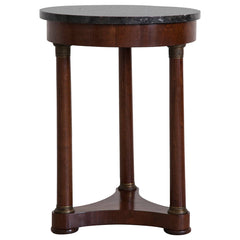 The Empire style was propaganda for the Emperor Napoléon I. The Emperor was for France her Alexander the Great, her Caesar, and the analogy was no more visible than in the monumental style that harkened back to the ancients. The Rome of Augustus, the Greece of the oracles, the Pharaohs of Egypt, and the Macedonia of Alexander the Great were the only worthy models for the new French Empire.
The Empire style was propaganda for the Emperor Napoléon I. The Emperor was for France her Alexander the Great, her Caesar, and the analogy was no more visible than in the monumental style that harkened back to the ancients. The Rome of Augustus, the Greece of the oracles, the Pharaohs of Egypt, and the Macedonia of Alexander the Great were the only worthy models for the new French Empire.
Napoléon centralized artistic production, making it subject to control from Paris. Government exhibitions replaced the traditional guilds. The new elite imitated shamelessly its master and the result was the unprecedented success and uniformity of the Empire style.
Abroad
England: The Regency style
Italy: The Neoclassical style
Spain: The Joseph Bonaparte style
Furniture
The Empire style is spare, noble, and massive. Its majesty lies in its imposing presence. Surfaces are flat and corners are sharp. Moldings are non-existent. Solemnity prevails over comfort. The small pieces of furniture for specific purposes became more rare.
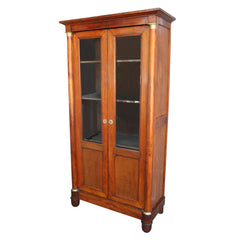 Materials & Techniques
Materials & Techniques
Mahogany was the wood of choice, be it blond, dark, moiré, figured, or flame. After 1810, mahogany became unavailable because of the continental blockade and furniture makers were forced to use walnut, burled elm, beech, ash, boxwood, olivewood, maple, and rarely citronnier. Complex marquetry disappeared and was replaced by discreet inlay ornament. Fillets of blond wood, copper or steel were set into dark wood. Fillets of dark wood were set into blond wood. If chairs were gilded so was their ornament. If painted, their ornament was painted or gilded as well. Bronze fittings were the only ornaments on furniture. They are placed symmetrically on flat surfaces and are delicately chased. Marble tops have sharp corners and are most often gray or black.
Ornament
Symmetry is de rigueur in all Empire ornament. The motifs on a piece's right and left ides generally correspond to one another in every detail. When they do not, the individual motifs themselves are entirely symmetrical in composition. For example, antique heads with identical tresses fall onto each shoulder or identical swans flank either side of a lock plate.
Napoléon, like Louis XIV, had a set of emblems unmistakably associated with his rule. These were the eagle, the bee, stars and the initials I (for Imperator) and N (for Napoleon) inscribed within an imperial laurel crown. Motifs of human origin include figures of Victory bearing palm branches, Greek dancers, nude and draped women, and masks of Apollo and Hermes. Swans, lions, the heads of oxen, horses, butterflies, claws, and sea horses are among the motifs of animal origin of the period. Compact rose wreaths, oak wreaths, climbing grape vines and "Egyptian" waterleaves are motifs of vegetal origin. Circles, squares, lozenges, octagons and ovals often frame Greco-Roman and Egyptian motifs.
Restauration Period: 1815-1830
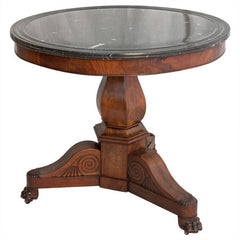 The Restauration period arrived on the heels of defeat after Waterloo ended the Napoleonic dream of grandeur. The two brothers of Louis XVI reigned during this period: the comte of Provence who reigned as Louis XVIII (1815-23) and the comte d'Artois, Charles X (1823-1830) who was the last of the Bourbon kings. They sought to revive the culture of the former monarchy. The Restauration was a reaction to the pomp of the Empire. It fostered an elegance and refinement that was lacking in the grandeur of the Napoléon period. Mahaugany was deemed too heavy and was replaced by blond woods. Smaller pieces of furniture in small reception rooms and boudoirs came back into fashion. However, the Restauration continued in the neoclassical tradition and can be seen as a refinement of the Empire style.
The Restauration period arrived on the heels of defeat after Waterloo ended the Napoleonic dream of grandeur. The two brothers of Louis XVI reigned during this period: the comte of Provence who reigned as Louis XVIII (1815-23) and the comte d'Artois, Charles X (1823-1830) who was the last of the Bourbon kings. They sought to revive the culture of the former monarchy. The Restauration was a reaction to the pomp of the Empire. It fostered an elegance and refinement that was lacking in the grandeur of the Napoléon period. Mahaugany was deemed too heavy and was replaced by blond woods. Smaller pieces of furniture in small reception rooms and boudoirs came back into fashion. However, the Restauration continued in the neoclassical tradition and can be seen as a refinement of the Empire style.
Abroad
England: The Regency
Italy: Late Neoclassicism
Spain: Neoclassicism
Furniture
The basic shapes of Empire pieces survive but with softer lines. Elegance and unpretentious harmony characterize the Restauration style. The furniture of this period is comfortable, gracious and portable.
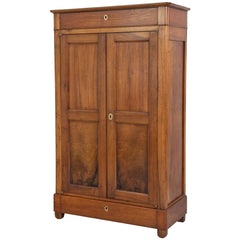 Materials & Techniques
Materials & Techniques
The use of veneer, solid-wood construction, and inlay work were all employed adeptly by the skilled craftsmen of the day. The use of light wood against dark wood grounds is typical, but during the reign of Charles X, inlays of dark wood were set into blond grounds. The darks woods used were mahogany, rosewood, and purple wood. The choice of woods available was large and blond woods included varnished elm, ash, plane tree, bird's eye maple, burr thuya, sycamore, orange wood, citronnier, olive wood and acacia.
Bronze fittings are used more sparingly than under the Empire. Marble used on furniture tops can be pale gray with subtle veining, white or, less often, black. The corners of the tops are now rounded with cyma profiles on their fore-edges.
Ornament
Restauration ornament is light and refined. Moldings, now thin and delicate, reappear, having been abandoned during the Empire. Tulip moldings (cyma reversa moldings) are introduced at the tops of secretaries and commodes. Some Empire motifs survive such as palmettes, cornucopias, stars, swans, lyres and dolphins. However, they are in simplified form and are more stylized with a new lightness to them in comparison to their solemn Empire counterparts. Geometric motifs include squares, lozenges, rectangles, octagons and ellipses but less frequently than in Empire furniture. Ribbons are especially common. Allegorical and antique motifs become more rare. Gothic motifs such as decorative rose windows and Gothic tracery appear.
Louis-Philippe Period: 1830-1848
 The Louis-Philippe style was created for a busy but coddled bourgeoisie. It was less preoccupied with originality than it was with comfort and new techniques and production. It sought to reconcile the new large-scale production techniques of the day with the tradition of great French craftsmanship. The Louis-Philippe furniture was less expensive, yet made with just as much care as, furniture from preceding periods. Comfort was the priority for the newly rich bankers and industrialists and thus, practicality was a must. The new social class often lived in small apartments and so needed smaller furniture. The resulting pieces are sought after today since they are well suited to today's Parisian apartments.
The Louis-Philippe style was created for a busy but coddled bourgeoisie. It was less preoccupied with originality than it was with comfort and new techniques and production. It sought to reconcile the new large-scale production techniques of the day with the tradition of great French craftsmanship. The Louis-Philippe furniture was less expensive, yet made with just as much care as, furniture from preceding periods. Comfort was the priority for the newly rich bankers and industrialists and thus, practicality was a must. The new social class often lived in small apartments and so needed smaller furniture. The resulting pieces are sought after today since they are well suited to today's Parisian apartments.
Abroad
England: The Victorian style
Italy: Beginning of the Ottocento style
Spain: End of Ferdinand and beginning of Isabellin
Furniture
The Louis-Philippe style is an extension of the Restoration style. The same basic structures prevail but without the same elegance and refinement. Forms become heavy and ornament becomes formulaic.
 Materials & Techniques
Materials & Techniques
Dark woods replaced blond ones. Machine tools enter widespread use. Thus, execution of a piece is more rapid. Bronze fittings and marquetry work were eliminated since they added to production expenses. However, craftsmen still took great pride in quality workmanship. They selected woods with great care and still assembled and finished their pieces by hand.
Mahogany, rosewood and ebony are favored. Blond woods such as sycamore, burled elm, citronnier and maple are favored for the interior veneers of certain pieces such as secretaries. Brass fittings are rare but keyholes are sometimes surrounded by copper inlay ornament. Marble tops are gray black, or white and have molded cyma fore-edges. Inlay work is rare.
Ornament
Moldings disappear. Panels become flat and lack moldings. Support posts are straight and smooth and are bare of ornament. Their corners are rounded. Decorative motifs are few. Large leaf foliage and palmettes are carved on chair arms and table legs. The "frog's leg" motif often figures on the legs of Louis-Philippe chairs, settees and case furniture.
Second Empire Period: 1848-1870
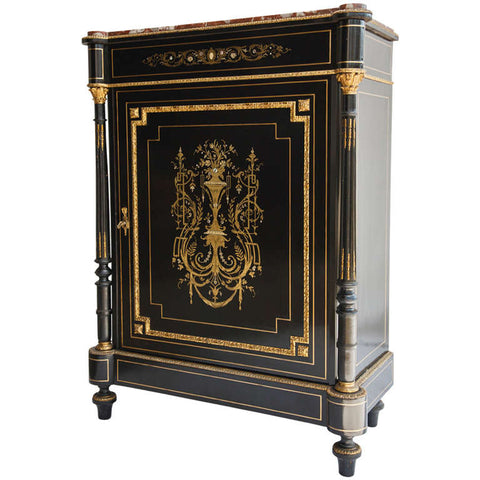 Also known as the Napoléon III period, the twenty year reign of the nephew of Napoléon I, was a period where science and industry were to triumph. This was a period of literal copies for the materials, forms, and ornamental motifs seen in the furniture produced during this period were all borrowed from preceding styles. Paris was being redesigned by Baron Haussmann and in its transformation; the furniture-makers of the faubourg Saint-Antoine were producing abundantly in order to furnish all of the new townhouses and apartments.
Also known as the Napoléon III period, the twenty year reign of the nephew of Napoléon I, was a period where science and industry were to triumph. This was a period of literal copies for the materials, forms, and ornamental motifs seen in the furniture produced during this period were all borrowed from preceding styles. Paris was being redesigned by Baron Haussmann and in its transformation; the furniture-makers of the faubourg Saint-Antoine were producing abundantly in order to furnish all of the new townhouses and apartments.
Abroad
England: The Victorian style
Italy: The Ottocento and neo-Gothic styles
Spain: The end of Isabellin
Furniture
The furniture of the Napoléon III period is most influenced by three styles: the Renaissance, Louis XV (rococo) and Louis XVI. Small pieces of all types are unceasingly developed to satisfy new needs in daily life.
Materials & Techniques
Dark woods are used and machine-assisted production methods are perfected during the Second Empire. Ebony, pitch pine, blackened pear wood, walnut, tulipwood and purple wood were all used. Wood coated with black lacquer, or blackened wood, which was used for small pieces with inlaid or painted decoration was the rage. Papier mâché was used beginning in 1850 in France. It was shaped by molding and was often inset with mother-of-pearl. Cuir bouilli (literally: "boiled leather") was used much like papier mâché as well. Gilt bronze was used as ornament, frame and case elements and was often made to resemble bamboo. Cast iron could now be produced cheaply and began to appear in furniture, especially in settees, beds and guéridon stands. The use of machine tools became widespread in all areas of furniture craft during the Napoléon III period.
Ornament
A variety of materials and techniques are employed in Second Empire ornament. Gilt-bronze fittings, copper, pewter, ivory and mother-of-pearl inlay, carved and gilded wood, applied porcelain plaques, painting on wood and panels of lacquered wood are some examples. Motifs from the Renaissance, Louis XV and Louis XVI are in fashion along with imagery of the Far East, Africa and Native Americas. Birds, pagodas, fret designs and figures in oriental pieces were part of the Louis XVI-Empress pieces (Empress Eugénie, wife of Napoléon III). Black caryatids were used a legs and support stands on tables. Imitation cord and bamboo was used for seating frames.
Style Moderne and Art Nouveau: 1889-1925
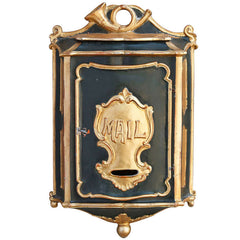 Furniture
Furniture
The style moderne, which encompasses Art Nouveau remained experimental, a style of theorists. It was the only original development in the domain of furniture design. The great furniture makers of the period include Majorelle, Vallin, Gallé, Gaillard and Cona. The Belle Epoque, that period of prosperity and gaiety surrounding the turn of the century, came to a close with the arrival of World War I (1914-1918).
Materials & Techniques
All materials and techniques were used by furniture-makers of the day that produced furniture inspired by every conceivable style throughout history. Craftsmen revived forgotten techniques. They also were adept at producing imitation Gothic, Renaissance and Louis XV work on an industrial scale. Brazilian mahogany came back into fashion. Oak, walnut and pear wood were also used. Ebony, sycamore and walnut were used for marquetry.
Metalwork became the "modern" material. Iron, steel, bronze, and cast iron were incorporated into furniture forms. Metal was fashioned into ribbons, serpentine columns, volutes, and scrolling foliage. It was usually left untreated. Copper, pewter and silver now became rare in furniture.
Ornament
Two themes dominate in the ornament of the 1900 style: Christian imagery incorporating Gothic and Renaissance elements and the nude. The rose motif is prevalent.
Motifs of the style moderne (and Art Nouveau) are inspired by the botanical. Marine plants such as water lilies and seaweeds as well as tropical vines and branches bare of leaves are prominent. Orchids and other exotic plants appear frequently. Eventually these botanical designs are transformed into loose and flowing women's hair. Geometric ornament disappears entirely. The rose disappears along with other familiar garden flowers except for the tulip in the Art Nouveau style.
Art Deco Period: 1925-1935
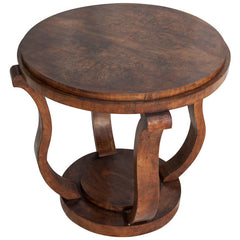 The curves and sinuous lines of the Belle Epoque and the work of the Cubist and abstract painters can both be seen in the furniture of the Art Deco period. The period's finest productions are the ones inspired by the eighteenth century French tradition.
The curves and sinuous lines of the Belle Epoque and the work of the Cubist and abstract painters can both be seen in the furniture of the Art Deco period. The period's finest productions are the ones inspired by the eighteenth century French tradition.
Furniture
The curves and sinuous lines of the Belle Epoque and the work of the Cubist and abstract painters can both be seen in the furniture of the Art Deco period. The period's finest productions are the ones inspired by the eighteenth century French tradition.
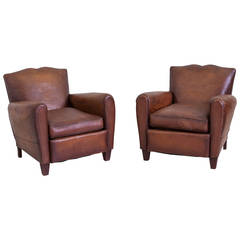 Materials & Techniques
Materials & Techniques
The Art Deco style was oriented toward the luxury market and therefore favored costly materials. Exotic woods were favored over European ones, especially dark woods such as ebony and macassar. Mahogany, palisander and yellow and rose amboine were also used. Lacquered woods were also often used. Gilt bronze, copper and now silver was used in ornament. Cast iron was also favored. Tan leather, often tooled, came into vogue as much as fabric as a cover material. Sharkskin, fur and pony skin were used on seating. Ivory was used in marquetry and inlay ornament. Luxurious silks were fashionable but gone were the use of embroidery and tapestry.
Ornament
Marquetry, inlay and decorative panels were all used as ornament. Wood sculpture was out of favor. New decorative motifs included geometric designs, a result of the influence of Cubism and abstraction. Ornament in the style moderne tradition (and Art Nouveau) drew from African art, vegetal, floral and maritime motifs (waves). Curved lines, contrasting colors and precious metals were prevalent.
Source: Chadenet, Sylvie. French Furniture from Louis XIII to Art Deco. Boston: Little, Brown and Company, 2001.

 Materials & Techniques
Materials & Techniques Ornament
Ornament Materials & Techniques
Materials & Techniques Materials & Techniques
Materials & Techniques Materials & Techniques
Materials & Techniques Materials & Techniques
Materials & Techniques Materials & Techniques
Materials & Techniques Furniture
Furniture Materials & Techniques
Materials & Techniques


